Buildings.Controls.OBC.CDL.Continuous.Validation
Collection of models that validate the continuous blocks of the CDL
Information
This package contains models that validate the blocks in Buildings.Controls.OBC.CDL.Continuous.
The examples plot various outputs, which have been verified against analytical solutions. These model outputs are stored as reference data to allow continuous validation whenever models in the library change.
Package Content
| Name | Description |
|---|---|
| Validation model for the absolute block | |
| Validation model for the add block | |
| Validation model for the AddParameter block | |
| Validation model for the Atan block | |
| Validation model for the Atan2 block | |
| Validation model for the Average block | |
| Validation model for the Cos block | |
| Validation model for the Division block | |
| Validation model for the Exp block | |
| Validation model for the Feedback block | |
| Validation model for the Gain block | |
| Validation model for the Greater block | |
| Validation model for the GreaterThreshold block | |
| Validation model for the Hysteresis block | |
| Test model for integrator with reset | |
| Validation model for the Less block | |
| Validation model for the LessThreshold block | |
| Validation model for the Limiter block | |
| Validation model for the Line block | |
| Validation model for the Log block | |
| Validation model for the Log10 block | |
| Validation model for the MatrixGain block | |
| Validation model for the MatrixMax block | |
| Validation model for the MatrixMin block | |
| Validation model for the Max block | |
| Validation model for the Min block | |
| Validation model for the Modulo block | |
| Validation model for the MovingMean block | |
| Validation model for the MovingMean block | |
| Validation model for the MultiMax block | |
| Validation model for the MultiMin block | |
| Model to validate the application of MultiSum block | |
| Test model for PID controller | |
| Test model for LimPID controller with initial output of the derivative term specified | |
| Test model for LimPID controller with initial state specified | |
| Test model for PID controller with scaling of the control error | |
| Test model for LimPID controller with reset trigger | |
| Test model for PID controller with reset and scaling of the control error | |
| Validation model for the Product block | |
| Validation model for the Round block | |
| Validation model for the Sin block | |
| Validation model for the SlewRateLimiter block | |
| Validation model for the Sort block | |
| Validation model for the Sqrt block | |
| Validation model for the Tan block |
 Buildings.Controls.OBC.CDL.Continuous.Validation.Abs
Buildings.Controls.OBC.CDL.Continuous.Validation.Abs
Validation model for the absolute block

Information
Validation test for the block Buildings.Controls.OBC.CDL.Continuous.Abs. The input varies from -1 to +1.
Modelica definition
 Buildings.Controls.OBC.CDL.Continuous.Validation.Add
Buildings.Controls.OBC.CDL.Continuous.Validation.Add
Validation model for the add block
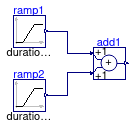
Information
Validation test for the block Buildings.Controls.OBC.CDL.Continuous.Add.
The input u1 varies from -2 to +2, input u2 varies from -1 to +1.
Modelica definition
 Buildings.Controls.OBC.CDL.Continuous.Validation.AddParameter
Buildings.Controls.OBC.CDL.Continuous.Validation.AddParameter
Validation model for the AddParameter block

Information
Validation test for the block Buildings.Controls.OBC.CDL.Continuous.AddParameter.
The input u varies from -2 to +2.
Modelica definition
 Buildings.Controls.OBC.CDL.Continuous.Validation.Atan
Buildings.Controls.OBC.CDL.Continuous.Validation.Atan
Validation model for the Atan block

Information
Validation test for the block Buildings.Controls.OBC.CDL.Continuous.Atan.
The input u varies from -2 to +2.
Modelica definition
 Buildings.Controls.OBC.CDL.Continuous.Validation.Atan2
Buildings.Controls.OBC.CDL.Continuous.Validation.Atan2
Validation model for the Atan2 block
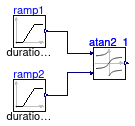
Information
Validation test for the block Buildings.Controls.OBC.CDL.Continuous.Atan2.
The input u1 varies from -2 to +2,
The input u2 varies from +1 to +3.
Modelica definition
 Buildings.Controls.OBC.CDL.Continuous.Validation.Average
Buildings.Controls.OBC.CDL.Continuous.Validation.Average
Validation model for the Average block
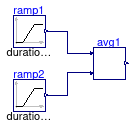
Information
Validation test for the block Buildings.Controls.OBC.CDL.Continuous.Average.
The input u1 varies from -2.0 to +6.0, input u2 varies from +1.5 to +4.5
Modelica definition
 Buildings.Controls.OBC.CDL.Continuous.Validation.Cos
Buildings.Controls.OBC.CDL.Continuous.Validation.Cos
Validation model for the Cos block

Information
Validation test for the block Buildings.Controls.OBC.CDL.Continuous.Cos.
The input u varies from 0.0 to +6.283.
Modelica definition
 Buildings.Controls.OBC.CDL.Continuous.Validation.Division
Buildings.Controls.OBC.CDL.Continuous.Validation.Division
Validation model for the Division block
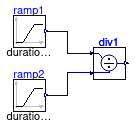
Information
Validation test for the block Buildings.Controls.OBC.CDL.Continuous.Division.
The input u1 varies from -2 to +2, input u2 varies from +1 to +3.
Modelica definition
 Buildings.Controls.OBC.CDL.Continuous.Validation.Exp
Buildings.Controls.OBC.CDL.Continuous.Validation.Exp
Validation model for the Exp block

Information
Validation test for the block Buildings.Controls.OBC.CDL.Continuous.Exp.
The input u varies from 0.0 to +2.
Modelica definition
 Buildings.Controls.OBC.CDL.Continuous.Validation.Feedback
Buildings.Controls.OBC.CDL.Continuous.Validation.Feedback
Validation model for the Feedback block
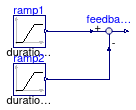
Information
Validation test for the block Buildings.Controls.OBC.CDL.Continuous.Feedback.
The input u1 varies from -2 to +2, input u2 varies from -1 to +1.
Modelica definition
 Buildings.Controls.OBC.CDL.Continuous.Validation.Gain
Buildings.Controls.OBC.CDL.Continuous.Validation.Gain
Validation model for the Gain block

Information
Validation test for the block Buildings.Controls.OBC.CDL.Continuous.Gain.
The input u varies from 0.0 to +2.
Modelica definition
 Buildings.Controls.OBC.CDL.Continuous.Validation.Greater
Buildings.Controls.OBC.CDL.Continuous.Validation.Greater
Validation model for the Greater block
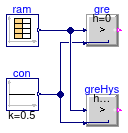
Information
Validation test for the block
Buildings.Controls.OBC.CDL.Continuous.Greater.
The instance gre has no hysteresis, and the
instance greHys has a hysteresis.
Modelica definition
 Buildings.Controls.OBC.CDL.Continuous.Validation.GreaterThreshold
Buildings.Controls.OBC.CDL.Continuous.Validation.GreaterThreshold
Validation model for the GreaterThreshold block
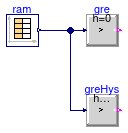
Information
Validation test for the block
Buildings.Controls.OBC.CDL.Continuous.GreaterThreshold.
The instance gre has no hysteresis, and the
instance greHys has a hysteresis.
Modelica definition
 Buildings.Controls.OBC.CDL.Continuous.Validation.Hysteresis
Buildings.Controls.OBC.CDL.Continuous.Validation.Hysteresis
Validation model for the Hysteresis block
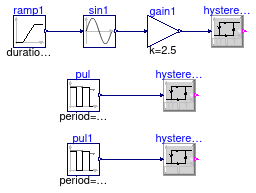
Information
Validation test for the block Buildings.Controls.OBC.CDL.Continuous.Hysteresis.
Modelica definition
 Buildings.Controls.OBC.CDL.Continuous.Validation.IntegratorWithReset
Buildings.Controls.OBC.CDL.Continuous.Validation.IntegratorWithReset
Test model for integrator with reset
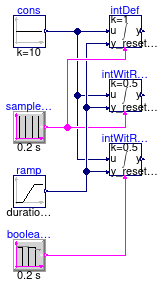
Information
This model tests the implementation of Buildings.Controls.OBC.CDL.Continuous.IntegratorWithReset with and without reset, and with different start values and reset values.
The integrator intWitRes1 is triggered by a sample trigger
which becomes true at t=0, while intWitRes2 is triggered
by a boolean pulse with is true at t=0.
Hence, intWitRes1 starts with y(0)=y_reset while
intWitRes2 starts with y(0)=y_start.
Modelica definition
 Buildings.Controls.OBC.CDL.Continuous.Validation.Less
Buildings.Controls.OBC.CDL.Continuous.Validation.Less
Validation model for the Less block
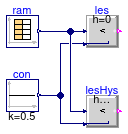
Information
Validation test for the block
Buildings.Controls.OBC.CDL.Continuous.Less.
The instance les has no hysteresis, and the
instance lesHys has a hysteresis.
Modelica definition
 Buildings.Controls.OBC.CDL.Continuous.Validation.LessThreshold
Buildings.Controls.OBC.CDL.Continuous.Validation.LessThreshold
Validation model for the LessThreshold block
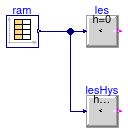
Information
Validation test for the block
Buildings.Controls.OBC.CDL.Continuous.LessThreshold.
The instance les has no hysteresis, and the
instance lesHys has a hysteresis.
Modelica definition
 Buildings.Controls.OBC.CDL.Continuous.Validation.Limiter
Buildings.Controls.OBC.CDL.Continuous.Validation.Limiter
Validation model for the Limiter block

Information
Validation test for the block Buildings.Controls.OBC.CDL.Continuous.Limiter.
The input u varies from 0.0 to +2.
Modelica definition
 Buildings.Controls.OBC.CDL.Continuous.Validation.Line
Buildings.Controls.OBC.CDL.Continuous.Validation.Line
Validation model for the Line block
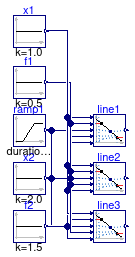
Information
Validation test for the block Buildings.Controls.OBC.CDL.Continuous.Line.
The input u varies from 0.0 to +2.
The block outputs y = a + b u,
where
u is an input
and the coefficients a and b
are determined so that the line intercepts the two input points
specified by the two points x1 and f1,
and x2 and f2.
The parameters limitBelow and limitAbove
determine whether x1 and x2 are also used
to limit the input u.
Modelica definition
 Buildings.Controls.OBC.CDL.Continuous.Validation.Log
Buildings.Controls.OBC.CDL.Continuous.Validation.Log
Validation model for the Log block

Information
Validation test for the block Buildings.Controls.OBC.CDL.Continuous.Log.
The input u varies from +1 to +6.
Modelica definition
 Buildings.Controls.OBC.CDL.Continuous.Validation.Log10
Buildings.Controls.OBC.CDL.Continuous.Validation.Log10
Validation model for the Log10 block

Information
Validation test for the block Buildings.Controls.OBC.CDL.Continuous.Log10.
The input u varies from +1 to +10.
Modelica definition
 Buildings.Controls.OBC.CDL.Continuous.Validation.MatrixGain
Buildings.Controls.OBC.CDL.Continuous.Validation.MatrixGain
Validation model for the MatrixGain block
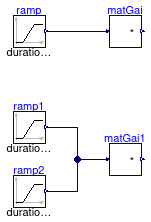
Information
Validation test for the block Buildings.Controls.OBC.CDL.Continuous.MatrixGain.
The input vector output two identical values u[1] and
u[2] that vary from 0.0 to +2.
Modelica definition
 Buildings.Controls.OBC.CDL.Continuous.Validation.MatrixMax
Buildings.Controls.OBC.CDL.Continuous.Validation.MatrixMax
Validation model for the MatrixMax block
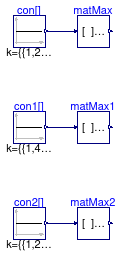
Information
Validation test for the block Buildings.Controls.OBC.CDL.Continuous.MatrixMax.
Modelica definition
 Buildings.Controls.OBC.CDL.Continuous.Validation.MatrixMin
Buildings.Controls.OBC.CDL.Continuous.Validation.MatrixMin
Validation model for the MatrixMin block
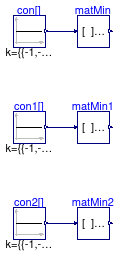
Information
Validation test for the block Buildings.Controls.OBC.CDL.Continuous.MatrixMin.
Modelica definition
 Buildings.Controls.OBC.CDL.Continuous.Validation.Max
Buildings.Controls.OBC.CDL.Continuous.Validation.Max
Validation model for the Max block
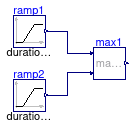
Information
Validation test for the block Buildings.Controls.OBC.CDL.Continuous.Max.
The input u1 varies from -2 to +2, input u2 varies from -1 to +1.
Modelica definition
 Buildings.Controls.OBC.CDL.Continuous.Validation.Min
Buildings.Controls.OBC.CDL.Continuous.Validation.Min
Validation model for the Min block
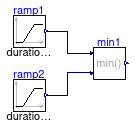
Information
Validation test for the block Buildings.Controls.OBC.CDL.Continuous.Min.
The input u1 varies from -2 to +2, input u2 varies from -1 to +1.
Modelica definition
 Buildings.Controls.OBC.CDL.Continuous.Validation.Modulo
Buildings.Controls.OBC.CDL.Continuous.Validation.Modulo
Validation model for the Modulo block
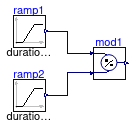
Information
Validation test for the block Buildings.Controls.OBC.CDL.Continuous.Modulo.
The input u1 varies from -2.0 to +6.0, input u2 varies from +1.5 to +4.5
Modelica definition
 Buildings.Controls.OBC.CDL.Continuous.Validation.MovingMean
Buildings.Controls.OBC.CDL.Continuous.Validation.MovingMean
Validation model for the MovingMean block
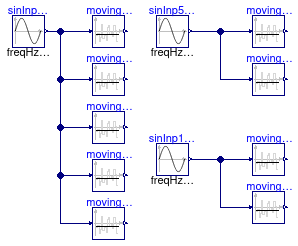
Information
Validation test for the block Buildings.Controls.OBC.CDL.Continuous.MovingMean.
The input sinInpNoDel, sinInp50sDel,
sinInp100sDel, generate sine outputs with same frequency of
1/80 Hz, but different start times of 0 second,
50 second, 100 second.
Modelica definition
 Buildings.Controls.OBC.CDL.Continuous.Validation.MovingMean_nonZeroStart
Buildings.Controls.OBC.CDL.Continuous.Validation.MovingMean_nonZeroStart
Validation model for the MovingMean block

Information
Validation test for the block Buildings.Controls.OBC.CDL.Continuous.MovingMean.
The inputs sinInpNoDel, sinInp50sDel and
sinInp100sDel generate sine outputs with the same frequency of
1/80 Hertz, but different start times of 0 seconds,
50 seconds and 100 seconds.
Modelica definition
 Buildings.Controls.OBC.CDL.Continuous.Validation.MultiMax
Buildings.Controls.OBC.CDL.Continuous.Validation.MultiMax
Validation model for the MultiMax block

Information
Validation test for the block Buildings.Controls.OBC.CDL.Continuous.MultiMax.
The input vectorcon has size 5 and its element values are {1,2,3,4,5}.
Parameters
| Type | Name | Default | Description |
|---|---|---|---|
| Integer | sizOfVec | 5 | Size of the input vector |
Modelica definition
 Buildings.Controls.OBC.CDL.Continuous.Validation.MultiMin
Buildings.Controls.OBC.CDL.Continuous.Validation.MultiMin
Validation model for the MultiMin block

Information
Validation test for the block Buildings.Controls.OBC.CDL.Continuous.MultiMin.
The input vectorcon has size 5 and its element values are {1,2,3,4,5}.
Parameters
| Type | Name | Default | Description |
|---|---|---|---|
| Integer | sizOfVec | 5 | Size of the input vector |
Modelica definition
 Buildings.Controls.OBC.CDL.Continuous.Validation.MultiSum
Buildings.Controls.OBC.CDL.Continuous.Validation.MultiSum
Model to validate the application of MultiSum block
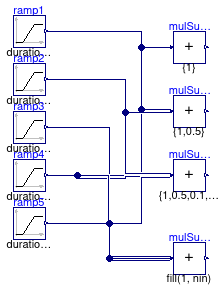
Information
Validation test for the block Buildings.Controls.OBC.CDL.Continuous.MultiSum.
The inputs and gains are configured as follows:
- u1 varies from -2 to +2, with gain k = 1.
- u2 varies from -1 to +1, with gain k = 0.5.
- u3 varies from -1 to +2, with gain k = 0.1.
- u4 varies from -2 to +1, with gain k = 1.
- u5 varies from -3 to 0, with gain k = 2.
Modelica definition
 Buildings.Controls.OBC.CDL.Continuous.Validation.PID
Buildings.Controls.OBC.CDL.Continuous.Validation.PID
Test model for PID controller
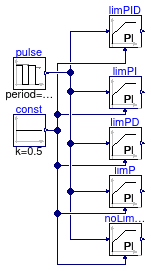
Information
Validation test for the block Buildings.Controls.OBC.CDL.Continuous.PID. This tests the different settings for the controller types.
Modelica definition
 Buildings.Controls.OBC.CDL.Continuous.Validation.PIDInitialDerivativeOutput
Buildings.Controls.OBC.CDL.Continuous.Validation.PIDInitialDerivativeOutput
Test model for LimPID controller with initial output of the derivative term specified
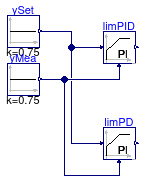
Information
Validation test for the block Buildings.Controls.OBC.CDL.Continuous.PID.
This model validates setting the initial output of the controller to a specified value. Note that the control error must be zero for the initial output to be at the specified value. See the description of Buildings.Controls.OBC.CDL.Continuous.PID.
Modelica definition
 Buildings.Controls.OBC.CDL.Continuous.Validation.PIDInitialState
Buildings.Controls.OBC.CDL.Continuous.Validation.PIDInitialState
Test model for LimPID controller with initial state specified
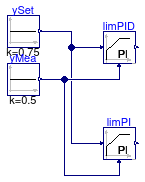
Information
Validation test for the block Buildings.Controls.OBC.CDL.Continuous.PID.
This model validates setting the initial state of the controller to a specified value.
The model sets the initial values xi_start=0.25
of the integrator for both instances of the controller.
For the instance limPID, it also sets the initial value of the state of the
derivative block xd_start=-0.5.
The derivative block obtains as an input signal the value
u=-0.5 because the set point weight for the derivative action is wd=0.
Therefore, an initial state of x(t0)=-0.5 causes the state of the derivative
block to be at steady-state, because
dx(t)/dt = (u - x)/T.
Modelica definition
 Buildings.Controls.OBC.CDL.Continuous.Validation.PIDScale
Buildings.Controls.OBC.CDL.Continuous.Validation.PIDScale
Test model for PID controller with scaling of the control error
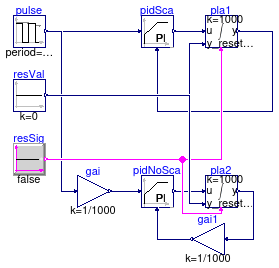
Information
Validation test for the block Buildings.Controls.OBC.CDL.Continuous.PID with and without setting of the parameter that scales the control error.
The test has two combinations of a PID controller and a plant.
In PIDSca, the control error is scaled inside the controller, whereas
in the configuration that has PIDNoSca, the setpoint signal and the
measurement signal is scaled outside of the controller.
Both controllers and plants have the same trajectory, thereby validating that
the scaling is implemented correctly.
Modelica definition
 Buildings.Controls.OBC.CDL.Continuous.Validation.PIDWithReset
Buildings.Controls.OBC.CDL.Continuous.Validation.PIDWithReset
Test model for LimPID controller with reset trigger
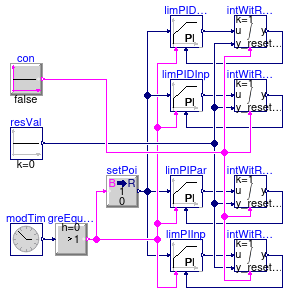
Information
Validation test for the block Buildings.Controls.OBC.CDL.Continuous.PID.
This model validates the controller for different settings of the control output reset.
Modelica definition
 Buildings.Controls.OBC.CDL.Continuous.Validation.PIDWithResetScale
Buildings.Controls.OBC.CDL.Continuous.Validation.PIDWithResetScale
Test model for PID controller with reset and scaling of the control error
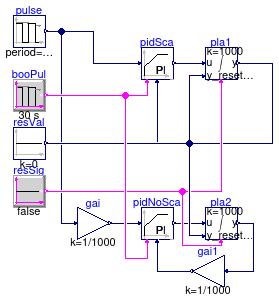
Information
Validation test for the block Buildings.Controls.OBC.CDL.Continuous.PIDWithReset with and without setting of the parameter that scales the control error.
The test has two combinations of a PID controller and a plant.
In PIDSca, the control error is scaled inside the controller, whereas
in the configuration that has PIDNoSca, the setpoint signal and the
measurement signal is scaled outside of the controller.
Both controllers and plants have the same trajectory, thereby validating that
the scaling is implemented correctly.
Modelica definition
 Buildings.Controls.OBC.CDL.Continuous.Validation.Product
Buildings.Controls.OBC.CDL.Continuous.Validation.Product
Validation model for the Product block
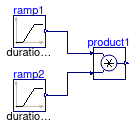
Information
Validation test for the block Buildings.Controls.OBC.CDL.Continuous.Product.
The input u1 varies from -2 to +2, input u2 varies from -1 to +2.
Modelica definition
 Buildings.Controls.OBC.CDL.Continuous.Validation.Round
Buildings.Controls.OBC.CDL.Continuous.Validation.Round
Validation model for the Round block
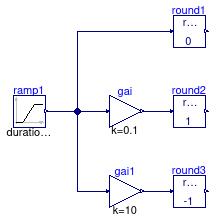
Information
Validation test for the block Buildings.Controls.OBC.CDL.Continuous.Round.
The input u varies from -3.5 to +3.5.
Modelica definition
 Buildings.Controls.OBC.CDL.Continuous.Validation.Sin
Buildings.Controls.OBC.CDL.Continuous.Validation.Sin
Validation model for the Sin block

Information
Validation test for the block Buildings.Controls.OBC.CDL.Continuous.Sin.
The input u varies from 0.0 to +2π.
Modelica definition
 Buildings.Controls.OBC.CDL.Continuous.Validation.SlewRateLimiter
Buildings.Controls.OBC.CDL.Continuous.Validation.SlewRateLimiter
Validation model for the SlewRateLimiter block
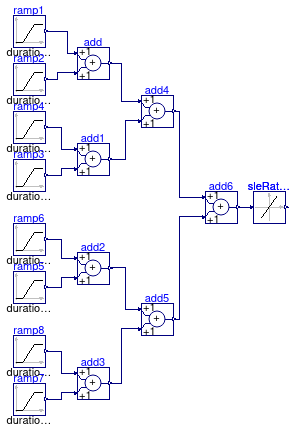
Information
Validation test for the block Buildings.Controls.OBC.CDL.Continuous.SlewRateLimiter.
The input ramp1.u varies from 0 to +1.5,
in 1 s.
The increase and decrease rate limits are [increase/incDt, -decrease/decDt] , which is [1, -1] here.
Modelica definition
 Buildings.Controls.OBC.CDL.Continuous.Validation.Sort
Buildings.Controls.OBC.CDL.Continuous.Validation.Sort
Validation model for the Sort block
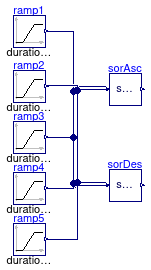
Information
Validation test for the block Buildings.Controls.OBC.CDL.Continuous.Sort.
The input u1 varies from -2 to +2, input u2 varies from -1 to +2,
input u3 varies from +2 to -2, input u4 varies from +3 to +2,
input u5 varies from 0 to +4,
Modelica definition
 Buildings.Controls.OBC.CDL.Continuous.Validation.Sqrt
Buildings.Controls.OBC.CDL.Continuous.Validation.Sqrt
Validation model for the Sqrt block

Information
Validation test for the block Buildings.Controls.OBC.CDL.Continuous.Sqrt.
The input u varies from 0.0 to +9.0.
Modelica definition
 Buildings.Controls.OBC.CDL.Continuous.Validation.Tan
Buildings.Controls.OBC.CDL.Continuous.Validation.Tan
Validation model for the Tan block

Information
Validation test for the block Buildings.Controls.OBC.CDL.Continuous.Tan.
The input u varies from -1.5 to +1.5.
